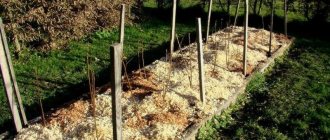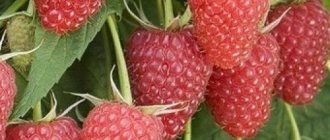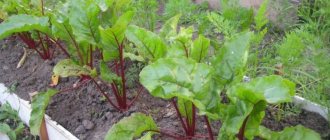Common raspberry varieties
They are more similar than others to the original crop, which is wild raspberries. The taste characteristics of the berries are unforgettable. These varieties have stood the test of time and quickly adapt to cultivation conditions.
Their low maintenance requirements are accompanied by small fruit size and low yield.
Lazarevskaya
The berries are medium in size, weighing 2-3 g. The oblong shape is accompanied by a dull red tint. They are distinguished by a bright, rich taste against the background of reduced aroma. One bush brings from 2 to 2.5 kg of raspberries.
The plant almost does not suffer from frosts and fungal diseases. The main disadvantage is that there is no immunity to raspberry mites.
Brigantine
Begins to bear fruit late. The berries are large in size, weight can reach up to 4 g. The round-shaped fruits have a bright pomegranate hue and are very pleasant to the taste.
The height of the plant reaches 1.9 m. Brigantine is not afraid of cold weather, lack of moisture, anthracnose and attack by the raspberry mite.
Crane
The berries are large in size, weigh 2-3 g. They are a short red cone with a rich taste. Due to its dense structure, raspberries are highly transportable.
The bushes of this variety are compact and small in height. 2 kg of berries are harvested from one. The degree of resistance to cold is average, to raspberry mites and diseases caused by fungi is high.
Where is the best place to plant in the country?
Raspberry bushes require certain growing conditions. This is important for getting a good harvest. If something does not meet certain requirements, then the berries will be smaller, their size will be small, and they will taste very sour. That is, the taste and quality characteristics will decrease significantly.
Here are the basic requirements that you need to remember when growing remontant raspberries in the Moscow region or in other regions:
- you need a bright place, the plant does not like shade;
- groundwater should not pass under the raspberry tree at a depth of about one meter;
- the soil must have neutral acidity;
- It is recommended to plant along the fence to protect the crop from gusts of wind;
- Do not plant in lowlands if moisture accumulates there;
- the soil should be loamy or sandy loam.
These are the basic requirements that are important to follow when growing raspberries. If they are not adhered to, the qualitative and quantitative indicators may decline sharply.
Large-fruited raspberries for the Moscow region
Their distinctive feature is increased productivity and marketable characteristics of the fruit. Raspberries can retain their presentation for a long time and be stored for a long time.
Such varieties are used for industrial purposes and for cultivation in garden plots.
Arbat
This variety is distinguished from other varieties by the large weight of the berries (15-18 g). The berries are dark burgundy, with a dense structure and elongated shape. They easily tear away from the branches, maintaining their integrity.
More on the topic: Remontant Nizhny Novgorod raspberry with a record large berry
The fruits can be eaten fresh, made into jam and preserves, and used to decorate confectionery products. About 9 kg of berries are collected from the bush. Its height reaches 1.9 m.
Raspberry Arbat is characterized by an increased degree of resistance to low temperatures and most diseases.
Nizhny Novgorod
The berries grow to incredible sizes - a weight of 12 g is not the limit for them. Can be used for industrial purposes and for personal use.
The Nizhegorodets variety was developed by breeders of the Nizhny Novgorod region. The berries are conical in shape, a bit like a thimble, dark red in color. They taste sweet, and 2-2.5 kg are collected from a bush.
Care after landing
Once planted, raspberries do not require special care. However, there are several nuances that are important to know about in order to get a good harvest.
- Fertilizing should be done with organic matter and only at the beginning of spring, 3 weeks before the cold weather. During the flowering period, setting buds and during the period of active growth, minerals are needed: potassium, magnesium, iron, phosphorus and superphosphate.
- Watering occurs when the soil dries to a depth of 5 cm. In this case, only 10-15 liters of water should be used per bush. If planting was done using a trench type, then water should be used per square meter. On average, about 50 liters of water are required. Excess moisture can lead to rotting of the root system.
- After each watering, you need to loosen the soil and remove weeds.
- Before wintering, be sure to prune the shoots. Dry and diseased ones are removed. Also, all other branches are shortened to one meter, and the trimmings are burned, as they may contain pathogenic bacteria and other microorganisms.
Remontant raspberry varieties for the Moscow region
Popular due to the ability to harvest several times per season. The size, taste and quality of the berries do not depend on the order of collection. The first harvest is in no way inferior to the final one.
Bryansk miracle
The variety belongs to the large-fruited variety. The berries weigh 9-11 g and have an oblong shape. Sweet and sour taste.
3 kg of raspberries are collected from the bush. The Bryansk miracle bears fruit from August to late autumn. The bushes do not freeze when it gets slightly colder and almost never get sick.
Diamond
The berries of this variety are large and can reach a weight of 7 g. Their shape is oblong and the color is ruby. They do not fall from the branches for a week after reaching full maturity.
During transportation they retain their quality. Plant height is 1.5 m. Diamond fruits are suitable for consumption both fresh and canned.
Firebird
This variety of remontant varieties belongs to the high-yielding varieties. The berries are medium in size, weigh 4-6 g, have a rich ruby color and easily come off the stem.
The taste contains sour notes. The bush grows up to 1.5-1.7 m. The fruits of the Firebird begin to form in mid-summer. Resistance to cold weather and disease is average.
Hercules
You can guess the size of the berries of the Hercules variety by its name. They weigh 10 g, taste sweet and sour and have a mild aroma. The fruits are mainly used for home canning.
The ripening process lasts from August to late autumn. The ability to form shoots is low, the bushes hardly grow. They can grow up to 1.5-2 m. The variety may suffer to a small extent from pests and diseases. Winters well in the climate near Moscow.
More on the topic: Indian Summer 2 raspberries
When to plant - spring or autumn?
Today there is no clear answer to this question. Some gardeners prefer to plant this crop in the fall, while others do it in the spring. Both seasons have their merits.
When planting in spring:
- raspberries are better prepared for wintering;
- you can understand how suitable the selected raspberry bushes are for further cultivation;
- the opportunity to get a summer harvest;
- the plant immediately begins active growth.
However, autumn planting also has many advantages, namely:
- saving fertilizers, since less of them are needed to warm up young roots;
- in spring, the crop immediately begins intensive growth without the need for acclimatization;
- strengthening plant immunity;
- the opportunity to understand which shoots will normally withstand the cold.
Thus, it is necessary to consider when to plant the plant, based on what time the planting material was received.
Standard raspberry varieties for the Moscow region
The advantages of this variety are ease of harvesting and a low percentage of berry and bud diseases. This is a new approach to the formation of bushes.
Due to the large thickness of the shoots and their height, raspberries are similar in appearance to a tree with a regular trunk, which is also called a trunk. This word gave the name to the new varieties.
Monomakh's hat
The berries are dark crimson and sweet in taste. Fruit formation lasts from August to late autumn. The fruits weigh 7 g. The degree of branching of Monomakh's Cap is high. Resistance to temperature decrease is high.
Glen Ample
The variety is widely known in European countries. The berries are round and slightly elongated in shape, pale red in color. They weigh 5-6 g, in rare cases 10. They taste sweet and sour and do not lose their presentation during transportation.
The height of the bushes is from 3.5 to 4 m. The yield of Glen Ampl is considered high and amounts to 1.6 kg. The plant does not suffer from frost, drought, major crop diseases and insect pests.
Tarusa
Bushes of the Tarusa variety are tall and grow without support. The berries weigh 10-13 g, are bright red in color, easily come off the stem and tolerate transportation well. One bush produces 3-4 kg of raspberries. The degree of resistance to cold is average.
Octavia
The variety was developed relatively recently by English breeders. The berries are large, weigh about 8 g and have a bright red color. They do not come off the stalk even after prolonged exposure to rain.
Octavia fruits have excellent taste characteristics and good transportability. The bushes grow small and bear 5 kg of berries. The variety is immune to cold weather and fungal diseases.
Varieties of yellow raspberries for the Moscow region
Yellow giant
Of the varieties of yellow-fruited raspberries, this is the most popular. Large-fruited, berries weigh 10-12 g, they are colored light yellow. The smell contains notes of honey, giving it a similarity to the smell of a wild variety of raspberry.
The pulp is very juicy, the fruits can be used for preservation and added to fruit salads. One bush produces 10-12 kg of berries. The yellow giant is characterized by resistance to the most common crop diseases and the effects of insect pests.
More on the topic: Early raspberry variety Malling Juneau
Orange miracle
This remontant variety is known primarily for its unusual fruit size. Their weight reaches 8-10 g. They are colored yellow and have a delicate taste. Thanks to their dense structure, they are easy to transport.
Harvesting can be done throughout the summer months. The bushes are small in height; due to their strong trunk, they do not need support. Shoots can grow up to 1.7 m. The Orange Miracle variety is not susceptible to frost and the main diseases characteristic of raspberries.
Yellow-fruited
Yellow raspberries are quite rare in the Moscow region. Many gardeners refuse to grow it due to poor transportability and unsuitability for processing, while forgetting about the advantages of sunny-colored berries. They are excellent for dietary nutrition due to their low acidity and low content of anthocyanins, which often cause allergies .
Table: yellow raspberry varieties popular in the Moscow region
Photo gallery: yellow-fruited raspberry varieties
Video: autumn fruiting of the Golden Domes variety
Early raspberry varieties for the Moscow region
Meteor
The productivity of the variety is high. Non-repairable, classified as ordinary. The berries are medium-sized, weigh 2-3 g, round in shape. They have a ruby color and a delicate scent. Harvesting can begin in June.
The height of the bush reaches 2 m, and the total weight of the collected fruits is 2 kg. Meteor does not suffer from low temperatures and is resistant to most diseases.
Maroseyka
Large-fruited early variety, characterized by the absence of thorns. The berries are large in size, red in color, they have a wonderful aroma and soft structure, weigh 12 g.
In terms of height, the plant belongs to the medium-sized variety and can grow up to 1.6 m. Thanks to its moderate frost resistance, the Maroseyka variety can be grown in the conditions of the Moscow region.
Patricia
This is one of the most productive varieties of raspberries. From one bush they harvest from 4.6 to 5 kg. Appropriate care and timely application of fertilizers in full will help double this figure.
The berries are large in size and shaped like an elongated cone of bright red color. They weigh 4-6 g. They come off the stem well and do not break. During the ripening process they do not fall off the branches.
The bushes belong to the category of medium-sized, their height can reach up to 1.7 m. The fruiting period lasts from July to August. Raspberry Patricia has tolerance to cold weather and some diseases.
What's the tastiest new species?
Every year more and more promising raspberry varieties appear. Some of them are quickly forgotten by gardeners, while others quickly spread throughout Russia.
It is impossible to identify the best variety, however, here are a few very promising ones:
- Glen Ample with a yield of up to 200 centners per hectare.
- Molling Minevra has excellent immunity to almost all known diseases, even to the RBDV virus. Fruiting is early.
- Octavia allows you to collect a record 25 tons of berries from one hectare.
Of course, there are many other interesting varieties. It is necessary to study new products in more detail in order to understand which ones are of the greatest interest at a particular time and place.
Preparing for winter
Before wintering, the following activities are carried out:
- remove the root shoots, leaving 3-4 layers;
- cut off diseased and damaged parts of the plant;
- mulch the soil abundantly.
Since the stems of standard varieties are quite dense, they are not stacked. Therefore, when choosing a variety, you need to pay attention to winter hardiness. It will not be possible to hide the shoots from frost.
Trimming and garter
To form a “tree”, the Sobolev method (double) is used:
- The top of the main stem is cut off by 20 cm when it grows to 90-120 cm.
- In June-July, the upper part of the side shoots is removed so that they are the same length as the trunk.
- In the spring of next year, cut off old shoots by 5-10 cm.
To prevent the bush from becoming overgrown and its branches not shading each other, you need to leave 3-7 branches and cut off the excess ones.
Reproduction methods
Raspberries are propagated in the usual ways: by root shoots and cuttings. In the first case, the young cuttings that appear next to the mother bush are carefully dug up. Then they are planted in prepared soil.
When propagating by cuttings, do the following:
- Carefully dig around the bush.
- Select a lateral root with formed buds.
- They are planted in containers with sand and peat soil.
- After germination, the bushes are transplanted to the site.
In spring and summer, cuttings can be planted directly into the ground. However, this reduces the survival rate of the plant, and gaps may remain in the raspberry tree.
Advantages and disadvantages
The main advantage of standard raspberries is their high yield. Other advantages of the variety include:
- frost resistance - many varieties tolerate frosts down to -30;
- good fruiting regardless of weather conditions;
- ability to withstand light shading without loss of yield;
- disease resistance;
- large size berries.
The powerful stems of remontant varieties can withstand a large weight of fruit. They do not break even with a bountiful harvest. Therefore, no garter is required for cultivation. This makes it easier to care for and reduces the cost of maintaining a raspberry tree.
The disadvantage is the need to allocate more space for one plant in a raspberry garden than when growing conventional varieties.
Important. Standard raspberries produce fewer offspring for propagation. There are enough of them to replace old bushes and expand the raspberry tree. However, it is unlikely that it will be possible to quickly and significantly increase planting areas using your own material.











